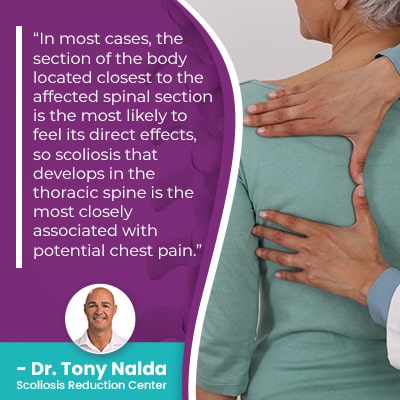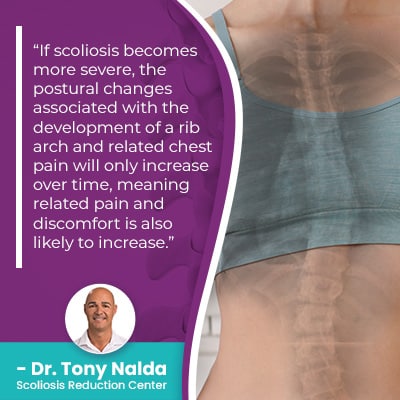Scoliosis & Chest Pain: Can Scoliosis Cause Chest Pain?

Scoliosis ranges widely in severity from mild to moderate and severe to very severe. The more severe a condition, the more noticeable its effects are likely to be. In children, the main scoliosis symptom is postural deviation, and in adults, it’s pain. Continue reading to learn more about scoliosis chest pain.
Scoliosis is a structural spinal condition, but its effects can be felt throughout the body, including the chest. One of the main effects of scoliosis is postural deviation that can involve the development of a rib arch, and this can cause varying levels of chest pain.
Let’s start our discussion on scoliosis chest pain by first defining the condition and some of its key characteristics.
Table of Contents
What is Scoliosis?
Scoliosis is a highly-prevalent spinal condition; current estimates of the Scoliosis Research Society have close to seven million people living with the condition in the United States alone.
Scoliosis is also the leading spinal condition amongst school-aged children.
Being diagnosed with scoliosis means an unnatural sideways spinal curvature, with rotation, has developed, and this introduces a lot of uneven forces to the spine, its surrounding muscles and nerves, and the entire body.
Scoliosis is also a progressive condition, meaning it has it in its nature to worsen over time, and mild to moderate and severe to very severe is the condition’s progressive line, as well as its severity levels.
Condition severity is determined by a measurement known as Cobb angle, and the higher a patient’s Cobb angle, the more severe their condition, and the more likely it is to cause noticeable effects.
Symptoms of Scoliosis
No two cases of scoliosis are the same as they involve a number of variables that can range widely from patient to patient.
Patient age, condition type, severity, and curvature location are key patient/condition variables that shape a patient’s experience of life with scoliosis.
Scoliosis affects all ages, but its most prevalent form is adolescent idiopathic scoliosis (AIS), diagnosed between the ages of 10 and 18.
In adolescents, the main symptom of scoliosis is postural deviation, and this is due to how the condition’s uneven forces disrupt the body’s overall symmetry.
Often, the earliest signs of scoliosis in children are uneven shoulders and hips, and additional postural changes can include:
- The head appearing uncentered over the torso
- An uneven eye line
- Uneven shoulder blades
- The development of a rib arch
- An uneven waistline
- Arms and legs that appear to hang at different lengths
As an unnatural spinal curve develops, it can shift the body’s center of gravity, and related postural changes can also cause changes to balance, coordination, and gait.
In adults, the main symptom of scoliosis is pain, and this is because scoliosis becomes a compressive condition once skeletal maturity has been reached.
In young patients who are still growing, the constant lengthening motion of a growing spine counteracts the compressive force of the unnatural spinal curve, and it’s compression of the spine and its surrounding muscles and nerves that causes the majority of condition-related pain.
In adults, it’s back pain and pain that radiates into the extremities, due to nerve compression, that most often brings them in for a diagnosis and treatment.
And what about chest pain? Is that a common symptom of scoliosis?
Scoliosis Chest Pain
As mentioned in the list of postural changes associated with scoliosis, the development of a rib arch is common.
There are three main spinal sections, and scoliosis can develop in any of them: the cervical spine (neck), thoracic spine (middle/upper back), and lumbar spine (lower back).
Scoliosis can also develop in more than one section as a combined scoliosis; for example, a scoliotic curve that develops in the upper lumbar spine and lower thoracic spine as thoracolumbar scoliosis.
 In most cases, the section of the body located closest to the affected spinal section is the most likely to feel its direct effects, so scoliosis that develops in the thoracic spine is the most closely associated with potential chest pain.
In most cases, the section of the body located closest to the affected spinal section is the most likely to feel its direct effects, so scoliosis that develops in the thoracic spine is the most closely associated with potential chest pain.
The thoracic spine is the most common section affected by scoliosis, and this is understandable as the largest spinal section.
When thoracic scoliosis causes the development of a rib arch, this is because as the thoracic spine is attached to the rib cage, as the unnatural spinal curve develops and progresses, it pulls on the rib cage, disrupting its position, and this can cause varying levels of pain.
In addition, as a scoliotic curve doesn’t just bend unnaturally to the side, but also twists, the rotational component can cause the rib cage to twist along with the spine.
In severe and/or very-severe cases, the postural deviation can be severe and cause a loss of space in the chest for the lungs to function optimally within, known as lung impairment.
Lung impairment caused by scoliosis is related to the lungs losing space and disrupting the ability to inhale fully.
It should be noted, however, that lung impairment is not a common symptom of scoliosis, is related to severe cases, and even then, is generally only noticeable to patients who place higher-than-average demands on their respiratory systems.
Professional athletes, long-distance runners, etc are the most likely to notice a change in lung function related to scoliosis.
Scoliosis can also affect the muscles that surround the spine, including the muscles of the chest that are also exposed to uneven forces; chest pains related to muscle spasms can also occur, although not a common symptom of scoliosis, but related muscle pain is associated with the condition.
How to Improve Scoliosis Chest Pain
Remember, as a progressive condition, where a scoliosis is at the time of diagnosis isn’t indicative of where it will stay.
The best way to address scoliosis symptoms is to proactively work towards preventing progression so condition-effects don’t increase.
 If scoliosis becomes more severe, the postural changes associated with the development of a rib arch and related chest pain will only increase over time, meaning related pain and discomfort is also likely to increase.
If scoliosis becomes more severe, the postural changes associated with the development of a rib arch and related chest pain will only increase over time, meaning related pain and discomfort is also likely to increase.
When it comes to addressing scoliosis chest pain, the scoliosis itself has to be treated, not just its symptoms, so impacting the condition’s underlying structural nature is essential.
Through condition-specific chiropractic care, I can apply a series of techniques and manual adjustments to work towards adjusting the position of the curve's most-tilted vertebrae; when successful, I can realign the spine and restore as much of the psine’s natural curves as possible.
By addressing the condition’s structural nature, including its rotational component, the underlying cause of its symptoms and effects have also been addressed, like postural changes to the chest and rib cage.
Once I see structural results, I can shift the focus of treatment to increasing core strength through physical therapy so the spine is optimally supported by its surrounding muscles.
In addition, physical therapy can also help improve posture, address any related muscle imbalance, and activate certain areas of the brain for improved brain-body communication.
Corrective bracing can also augment corrective treatment results by pursuing the spine into a corrective position, and the final phase of treatment is ongoing and involves a series of custom-prescribed home exercises to further stabilize, heal, and rehabilitate the spine.
Conclusion
The best way to minimize the potential effects of scoliosis, including chest pain, is to treat it proactively.
Scoliosis chest pain can become an issue when postural deviation includes the development of a rib arch, as this means the rib cage has been pulled and twisted due to the unnatural spinal curve bending and twisting.
Chest pain can also involve sore muscles and muscle spasms caused by the unnatural spinal curve pulling its surrounding muscles in different directions, which can also be associated with muscle imbalance.
Chest pain is also more likely to be an issue for older patients for whom the condition is compressive.
Addressing scoliosis chest pain means proactively treating the underlying cause of the postural changes and chest pain: the scoliosis itself.
Here at the Scoliosis Reduction Center, I start treatment as close to the time of diagnosis as possible because this is the time the spine is likely to be its most responsive to treatment: early in a condition’s progressive line.
Regardless of condition severity, the best time to start scoliosis treatment is always now, and although incurable, scoliosis can be highly treatable, particularly if detected and treated early.
So if you are experiencing chest pain related to your scoliosis, don’t hesitate to reach out as proactive conservative treatment could be the answer you’re looking for.
Dr. Tony Nalda
DOCTOR OF CHIROPRACTIC
After receiving an undergraduate degree in psychology and his Doctorate of Chiropractic from Life University, Dr. Nalda settled in Celebration, Florida and proceeded to build one of Central Florida’s most successful chiropractic clinics.
His experience with patients suffering from scoliosis, and the confusion and frustration they faced, led him to seek a specialty in scoliosis care. In 2006 he completed his Intensive Care Certification from CLEAR Institute, a leading scoliosis educational and certification center.
About Dr. Tony Nalda
 Ready to explore scoliosis treatment? Contact Us Now
Ready to explore scoliosis treatment? Contact Us Now





